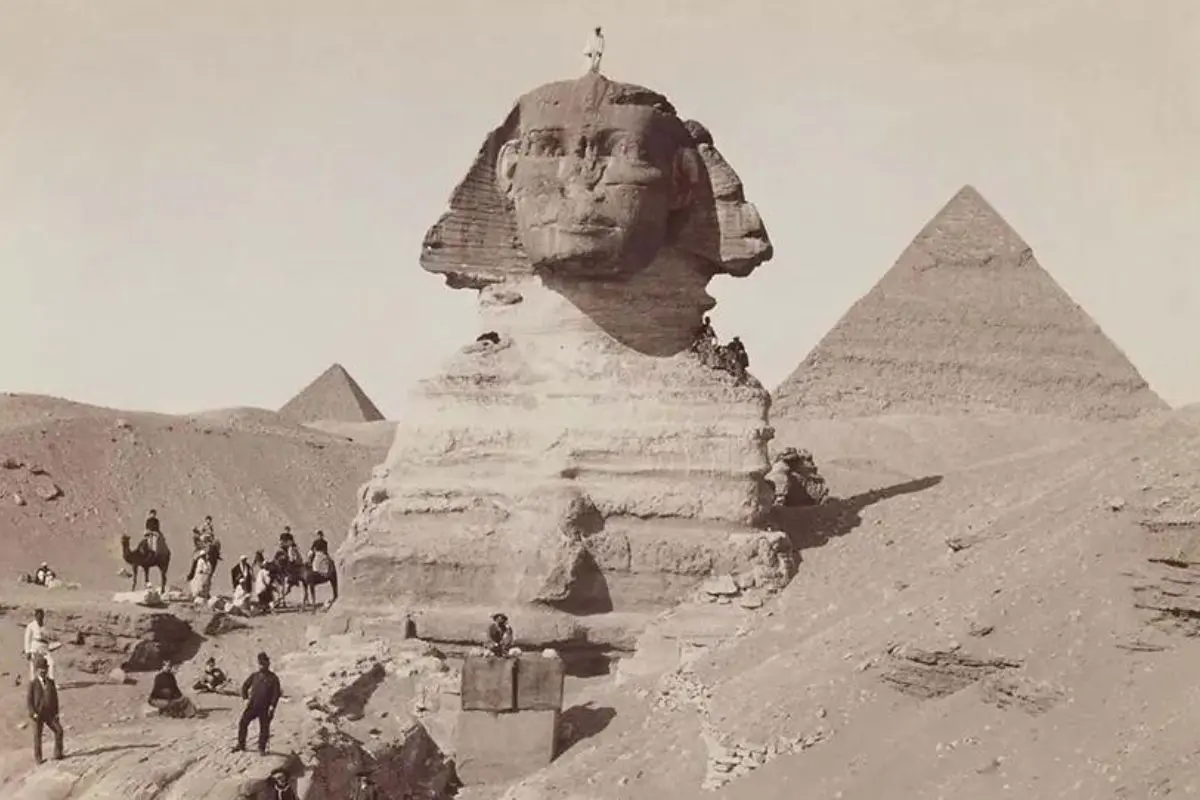Before you get set for Egypt, here are some FAQ and Facts about Great Sphinx of Egypt, which is a colossal limestone statue with the body of a lion and the head of a pharaoh, believed to represent the Pharaoh Khafre.

Sphinx stands on the Giza Plateau near Cairo, Egypt, and is one of the most iconic symbols of ancient Egyptian civilization.
Here are some FAQ and Facts about Sphinx Egypt
The exact purpose of the Egyptian Sphinx, specifically the Great Sphinx of Giza, remains a subject of scholarly debate, and there is no definitive answer. However, several theories have been proposed:
Guardian of the Pyramids: One theory suggests that the Sphinx was built as a guardian or protector of the nearby pyramids, particularly the Pyramid of Khafre.
The Sphinx’s imposing presence may have been intended to ward off evil spirits or serve as a symbol of royal power and authority.
Symbol of the Sun God: Some theories propose that the Sphinx represents the sun god Ra or the sun itself. The Sphinx faces the sunrise, and its association with solar symbolism could link it to the cycles of the sun and the afterlife.
Pharaoh’s Portrait: Another prevalent theory is that the Sphinx is a monumental portrait of a specific pharaoh, often identified as Khafre.
This interpretation suggests that the Sphinx served a commemorative or political purpose, immortalizing the ruler in a divine and powerful form.
Alignment with Constellations: There are hypotheses suggesting that the Sphinx may be aligned with certain constellations or served as an astronomical marker.
Some argue that its orientation is linked to celestial events or ancient Egyptian religious beliefs.
Water Erosion Hypothesis: Some researchers propose that the erosion patterns on the Sphinx’s body indicate water erosion, leading to speculation that it may have been constructed during a period when the region experienced more rainfall. This theory, however, is not universally accepted.
Some sources claim that Captain Giovanni Battista Caviglia discovered the Sphinx; however, the truth is that he did not. The Sphinx was already a well-known and prominent monument in Egypt when Caviglia conducted his work.
As an Italian explorer and military officer, Caviglia carried out excavations and investigations around the Giza Plateau in the early 19th century, focusing on areas near the Sphinx and the pyramids.
While Caviglia played a role in uncovering parts of the Sphinx, including clearing the accumulated sand, the credit for the discovery of the Sphinx itself does not belong to him.
The Sphinx has been an integral part of the Egyptian landscape for thousands of years, and its existence predates Caviglia’s explorations. The construction of the Sphinx is traditionally attributed to Pharaoh Khafre, who ruled during the Fourth Dynasty of ancient Egypt.
Ultimately, the purpose of the Sphinx remains shrouded in mystery, and it’s likely that multiple factors, including religious, political, and symbolic considerations, played a role in its construction. The lack of inscriptions or explicit records from the time adds to the intrigue surrounding this ancient monument.
The age of the Sphinx is estimated to be around 4,500 to 4,600 years old. Most scholars attribute its construction to the Pharaoh Khafre, who ruled during the Fourth Dynasty of the Old Kingdom of Egypt. This places the likely construction of the Great Sphinx at some point around 2558–2532 BCE.
The exact purpose of the Sphinx and the methods used for its construction remain subjects of debate among Egyptologists and archaeologists.
The construction of the Sphinx is traditionally attributed to the Pharaoh Khafre of the Fourth Dynasty of the Old Kingdom of Egypt.
Khafre is believed to have ruled Egypt from around 2558 to 2532 BCE, and the Great Sphinx is commonly associated with his reign.
The Sphinx is thought to have been built as part of the complex that includes the Pyramid of Khafre, situated on the Giza Plateau near Cairo.
While Khafre is the most widely accepted candidate as the builder, there is ongoing scholarly debate about the exact role of the Sphinx and the extent of his involvement.
The lack of inscriptions or direct evidence from the time period makes it challenging to confirm certain details about the construction and purpose of the Sphinx.
One of the most important Facts about Sphinx is the Width and height.
The Great Sphinx of Giza is an enormous statue with impressive dimensions. Here are some key measurements:
Length: The Sphinx is approximately 73.5 meters (241 feet) long from its hind legs to the tip of its paws.
Height: The height of the Sphinx is about 20.22 meters (66.34 feet) from the base to the top of the head.
Width: The width of the Sphinx is around 19.3 meters (63 feet).
On of the frequent asked question and fact about the Sphinx is that “how many years did it take to build the sphinx.
The exact duration of time it took to build the Great Sphinx of Giza is not precisely known, as there is no comprehensive historical record detailing the construction process.
Estimates and scholarly opinions vary, but it is generally believed that the Sphinx was built during the reign of Pharaoh Khafre, who ruled Egypt during the Fourth Dynasty of the Old Kingdom.
Construction of the Sphinx likely took several years, and it was likely part of a larger construction project that included the Pyramid of Khafre.
The construction of the pyramids and associated structures during this period involved a significant workforce, including skilled laborers, architects, and laborers. The exact techniques used in the construction of the Sphinx are also a subject of debate among Egyptologists.
While it’s challenging to provide a precise timeframe, it’s reasonable to assume that the construction of the Sphinx spanned several years, possibly during the latter part of Khafre’s reign, around 2558–2532 BCE.
The exact circumstances surrounding the loss of the Sphinx’s nose are unclear, and there is no definitive historical record explaining its removal.
The absence of the Sphinx’s nose has been a subject of speculation and curiosity for centuries, and several theories exist to explain this phenomenon.
Some of the prominent theories include:
Iconoclasm: One theory suggests that the nose of the Sphinx was intentionally damaged or destroyed by iconoclasts or religious zealots during a period of religious or political upheaval.
Iconoclasm refers to the deliberate destruction or mutilation of religious or iconic images, often as a result of religious or political conflicts.
Natural Erosion: Another theory proposes that the nose was eroded and weathered over time due to exposure to the elements. This could include wind erosion, sand abrasion, or other environmental factors. Some argue that the nose may have been particularly vulnerable due to its projection from the face.
Vandalism by Napoleon’s Army: A popular legend attributes the loss of the Sphinx’s nose to Napoleon Bonaparte’s soldiers during their campaign in Egypt in the late 18th century. According to this story, the soldiers used the Sphinx for target practice, and the nose was shot off. However, there is little historical evidence to support this claim, and it is generally considered a myth.
Despite various theories, the true reason for the missing nose remains uncertain. The Sphinx has undergone restoration and conservation efforts over the years, but the original cause of the nose’s removal remains a historical mystery.
The Sphinx of Egypt is often considered a symbol of ancient Egyptian kingship, strength, and guardian of the pyramids. Its human face, commonly associated with Pharaoh Khafre, suggests a divine connection, and its lion’s body signifies strength and protection.
The Sphinx’s alignment with the sun and celestial bodies also hints at its potential role in religious or astronomical symbolism. Despite varied interpretations, the Sphinx’s true purpose remains a historical enigma.
According to the informations from some proven and academic sources like Wikipedi, the original appearance of the Sphinx is a topic of speculation and debate among historians and archaeologists. The Sphinx’s overall structure is intact, but its nose and possibly a ceremonial beard are missing.
The Sphinx is believed to have had a long, slender beard that extended down its chest, emphasizing its royal and divine attributes.
As for its color, it is likely that the Sphinx was originally brightly painted.
Ancient Egyptian statues and monuments were often adorned with vibrant colors, but over time, exposure to the elements has caused the pigments to fade. The current appearance of weathered limestone gives the Sphinx its iconic sandy color.
To visualize the original look of the Sphinx, researchers rely on artistic representations from the time, as well as comparisons with other well-preserved artifacts from ancient Egypt. Despite these efforts, many details about the Sphinx’s original appearance remain speculative.
The theory of water erosion on the Egyptian Sphinx, particularly the Great Sphinx of Giza, is a subject of debate among scholars and researchers. Some proponents argue that certain patterns of erosion on the Sphinx’s enclosure walls and body could be indicative of water erosion, suggesting that the structure may be much older than conventionally believed.
Dr. Robert M. Schoch, a geologist, and other researchers have pointed to specific weathering patterns, such as deep vertical fissures and undulating erosion on the limestone blocks of the Sphinx, as potential evidence of prolonged exposure to water. This theory challenges the traditional dating of the Sphinx, which is commonly associated with the reign of Pharaoh Khafre in the Old Kingdom of ancient Egypt.
However, the water erosion hypothesis is not universally accepted. Many Egyptologists and geologists assert that the predominant cause of the Sphinx’s erosion is wind and sand, common in the arid climate of the Giza Plateau. Additionally, some researchers argue that the patterns identified as water erosion may be the result of a combination of factors, including subsurface weathering and the use of different types of limestone in the construction.
The debate over the age and origin of the Sphinx remains an intriguing aspect of Egyptology, with ongoing research and discussions within the scholarly community. It’s essential to consider multiple perspectives and approaches to gain a comprehensive understanding of this complex topic.
The Sphinx is a mythical creature with a lion’s body and a human head, often depicted in Egyptian and Greek mythology. Here are some fun facts about the Sphinx:
Great Sphinx of Giza: The most famous Sphinx is the Great Sphinx of Giza, located on the Giza Plateau near Cairo, Egypt. It is one of the largest and oldest statues in the world, believed to have been built around 2500 BCE during the reign of Pharaoh Khafre.
Guardian of the Pyramids: The Great Sphinx is situated near the Pyramids of Giza and is often considered a guardian or protector of the pyramids. Its exact purpose and significance remain a subject of debate among historians and archaeologists.
Missing Nose: The Great Sphinx is famously missing its nose, and the exact cause of its absence is unknown. There are various theories, including natural erosion, vandalism, or damage caused during conflicts.
Symbolism: In Egyptian mythology, the Sphinx is associated with protection and mystery. It often symbolizes the guardian of sacred places and the enigma of the unknown.
Greek Mythology: The Sphinx also appears in Greek mythology, where it is described as a creature with the head of a woman, the body of a lion, and wings of a bird. The Greek Sphinx is famous for posing a riddle to travelers, with a threat of death for those who couldn’t solve it.
The Riddle of the Sphinx: In Greek mythology, the Sphinx guarding the entrance to the city of Thebes posed a famous riddle to travelers: “What has one voice and is four-footed, two-footed, and three-footed?” Oedipus solved the riddle by answering, “Man,” as humans crawl on all fours as babies, walk on two legs as adults, and use a cane in old age.
Sphinxes in Art and Architecture: Sphinxes are common motifs in various cultures and can be found in art and architecture around the world. They often represent strength, wisdom, and mystery.
Sphinx in Popular Culture: The Sphinx has made appearances in various forms in literature, films, and other forms of popular culture. It continues to be a symbol that captures the imagination of people worldwide.
Alignment with the Sun: Some researchers believe that the Great Sphinx may have been aligned with certain celestial events, such as the rising sun on the vernal equinox, adding to the mystery surrounding its purpose.
Restoration Efforts: Over the years, there have been efforts to restore and preserve the Great Sphinx. Various restoration projects have taken place to address issues such as erosion and damage caused by environmental factors.
The Sphinx remains a fascinating and iconic symbol that has captivated people for centuries, with its enigmatic presence and rich cultural significance.

 Black Friday: 60% Off
Black Friday: 60% Off Croatia Sailing : Save up to 60%
Croatia Sailing : Save up to 60% Ski Bansko : 60% Off
Ski Bansko : 60% Off Central & Eastern Europe Tours: 60% Off
Central & Eastern Europe Tours: 60% Off  Why Travel Talk
Why Travel Talk Travel Talk Blog
Travel Talk Blog Responsible Travel
Responsible Travel Fair Travels with Travel Talk
Fair Travels with Travel Talk